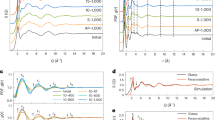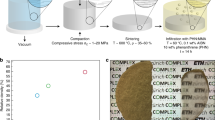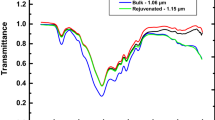Abstract
Nanoporous glasses are inherently brittle materials that become increasingly fragile with increasing porosity. We show that remarkable increases in fracture energy can be obtained from remnants of the porogen molecules used to create the nanoscale pores. The interfacial fracture energy of ∼2.6 J m−2 for dense methylsilsesquioxane glass films is shown to increase by over one order of magnitude to >30 J m−2 for glasses containing 50 vol.% porosity. The increased fracture resistance is related to a powerful molecular-bridging mechanism that was modelled using bridging mechanics. The study demonstrates that significant increases in interfacial fracture energy may be obtained using strategies involving controlled decomposition of the porogen molecule during processing of nanoporous glasses. The implications are important for a range of emerging optical, electronic and biological technologies that use nanoporous thin films, but are limited by the degradation of mechanical properties with increasing porosity.
This is a preview of subscription content, access via your institution
Access options
Subscribe to this journal
Receive 12 print issues and online access
$259.00 per year
only $21.58 per issue
Buy this article
- Purchase on Springer Link
- Instant access to full article PDF
Prices may be subject to local taxes which are calculated during checkout





Similar content being viewed by others
References
Miller, R.D. et al. Porous organosilicates using sacrificial macromolecular porogens. Polym. Mater. Sci. Eng. 87, 425–426 (2002).
Hedrick, J.L. et al. Templating nanoporosity in thin-film dielectric insulators. Adv. Mater. 10, 1049–1053 (1998).
Liu, J. et al. Porosity effect on the dielectric constant and thermomechanical properties of organosilicate films. Appl. Phys. Lett. 81, 4180–4182 (2002).
Maidenberg, D.A., Volksen, W., Miller, R.D. & Dauskardt, R.H. in International Interconnect Technology Conference 48–50 (IEEE, 1–4 June, Burlingame, California, 2003).
Lane, M., Dauskardt, R.H., Krishna, N. & Hashim, I. Adhesion and reliability of copper interconnects with Ta and TaN barrier layers. J. Mater. Res. 15, 203–211 (2000).
Maidenberg, D.A., Volksen, W., Miller, R.D. & Dauskardt, R.H. in Advances in Low-k Dielectrics and Thermally Stable Polymers for Microelectronics (eds Sachdev, H. S., Khojasteh, M. M. & McHerron, D.) 301–309 (Society of Plastics Engineers, McAfee, New Jersey, 2000).
Cook, R.F., Liniger, E.G., Klaus, D.P., Simonyi, E.E. & Cohen, S.A. in Low-Dielectric Constants IV 33–38 (MRS meeting 14–16 April, San Francisco, California, 1998).
Kim, S.M., Yoon, D.Y., Nguyen, C.V., Jie, H. & Jaffe, R.L. in Low-Dielectric Constant Materials IV 39–47 (MRS meeting 14–16 April, San Francisco, California, 1998).
Miller, R.D. et al. in Low-Dielectric Constant Materials V 3–15 (MRS meeting 5–8 April, San Francisco, California, 1999).
Nguyen, C.V. et al. in Low and high Dielectric Constant Materials: Materials Science, Processing, and Reliability 38–45 (ECS meeting, 2–6 May, Seattle, Washington, 1999).
Kamigaito, M., Ando, T. & Sawamoto, M. Metal-catalyzed living radical polymerization. Chem. Rev. 101, 3689–3745 (2001).
Hawker, C.J., Bosman, A.W. & Harth, E. New polymer synthesis by nitroxide mediated living radical polymerizations. Chem. Rev. 101, 3661–3688 (2001).
Lee, H.J. et al. Structural comparison of hydrogen silsesquioxane based porous low-k thin films prepared with varying process conditions. Chem. Mater. 14, 1845–1852 (2002).
Huang, E. et al. Pore size distributions in nanoporous methyl silsesquioxane films as determined by small angle X-ray scattering. Appl. Phys. Lett. 81, 2232–2234 (2002).
Liu, P.-T., Ting-Chang, C., Yi-Shian, M. & Sze, S.M. Enhancing the oxygen plasma resistance of low-k methylsilsesquioxane by H2 plasma treatment. Jpn J. Appl. Phys. 38, 3482–3486 (1999).
Ouyang, M., Yuan, C., Muisener, R.J., Boulares, A. & Koberstein, J.T. Conversion of some siloxane polymers to silicon oxide by UV/Ozone photochemical processes. Chem. Mater. 12, 1591–1596 (2000).
Liu, P.T. et al. The effects of plasma treatment for low dielectric constant hydrogen silsesquioxane (HSQ). Thin Solid Films 332, 345–350 (1998).
Kim, H.R., Park, H.H., Hyun, S.H. & Yeom, G.Y. Effect of O2 plasma treatment on the properties of SiO2 aerogel film. Thin Solid Films 332, 444–449 (1998).
Kim, H.-C. et al. Neutron reflectivity on nanoporous poly(methylsilsesquioxane) thin films. Chem. Mater. 15, 609–611 (2003).
Lane, M., Dauskardt, R.H., Vainchtein, A. & Huajian, G. Plasticity contributions to interface adhesion in thin-film interconnect structures. J. Mater. Res. 15, 2758–2769 (2000).
Strohband, S. & Dauskardt, R.H. Interface separation in residually stressed thin-film structures. Interface Sci. 11, 309–317 (2003).
Wei, Y. & Hutchinson, J.W. Models of interface separation accompanied by plastic dissipation at multiple scales. Intl J. Fracture 95, 1–4 (1999).
Bao, G. & Suo, Z. Remarks on crack bridging concepts. Appl. Mech. Rev. 45, 355–366 (1992).
Grandbois, M., Beyer, M., Rief, M., Clausen-Schaumann, H. & Gaub, H.E. How strong is a covalent bond? Science 283, 1727–1730 (1999).
Dauskardt, R.H., Lane, M., Ma, Q. & Krishna, N. Adhesion and debonding of multi-layer thin film structures. Eng. Fracture Mech. 61, 141–162 (1998).
Hughey, M. et al. Four-point bend adhesion measurements of copper and permalloy systems. Eng. Fracture Mech. 71, 245–261 (2004).
Acknowledgements
Work was supported primarily by a seed grant from the Stanford-CPIMA MRSEC Program of the National Science Foundation under Award Number DMR -0213618.
Author information
Authors and Affiliations
Corresponding author
Ethics declarations
Competing interests
The authors declare no competing financial interests.
Rights and permissions
About this article
Cite this article
Maidenberg, D., Volksen, W., Miller, R. et al. Toughening of nanoporous glasses using porogen residuals. Nature Mater 3, 464–469 (2004). https://doi.org/10.1038/nmat1153
Received:
Accepted:
Published:
Issue Date:
DOI: https://doi.org/10.1038/nmat1153
This article is cited by
-
Polymeric molecular sieve membranes via in situ cross-linking of non-porous polymer membrane templates
Nature Communications (2014)
-
Thermal Conductivity Measurement of Low-k Dielectric Films: Effect of Porosity and Density
Journal of Electronic Materials (2014)
-
Photo-oxidative enhancement of polymeric molecular sieve membranes
Nature Communications (2013)
-
Annealing-induced interfacial toughening using a molecular nanolayer
Nature (2007)



